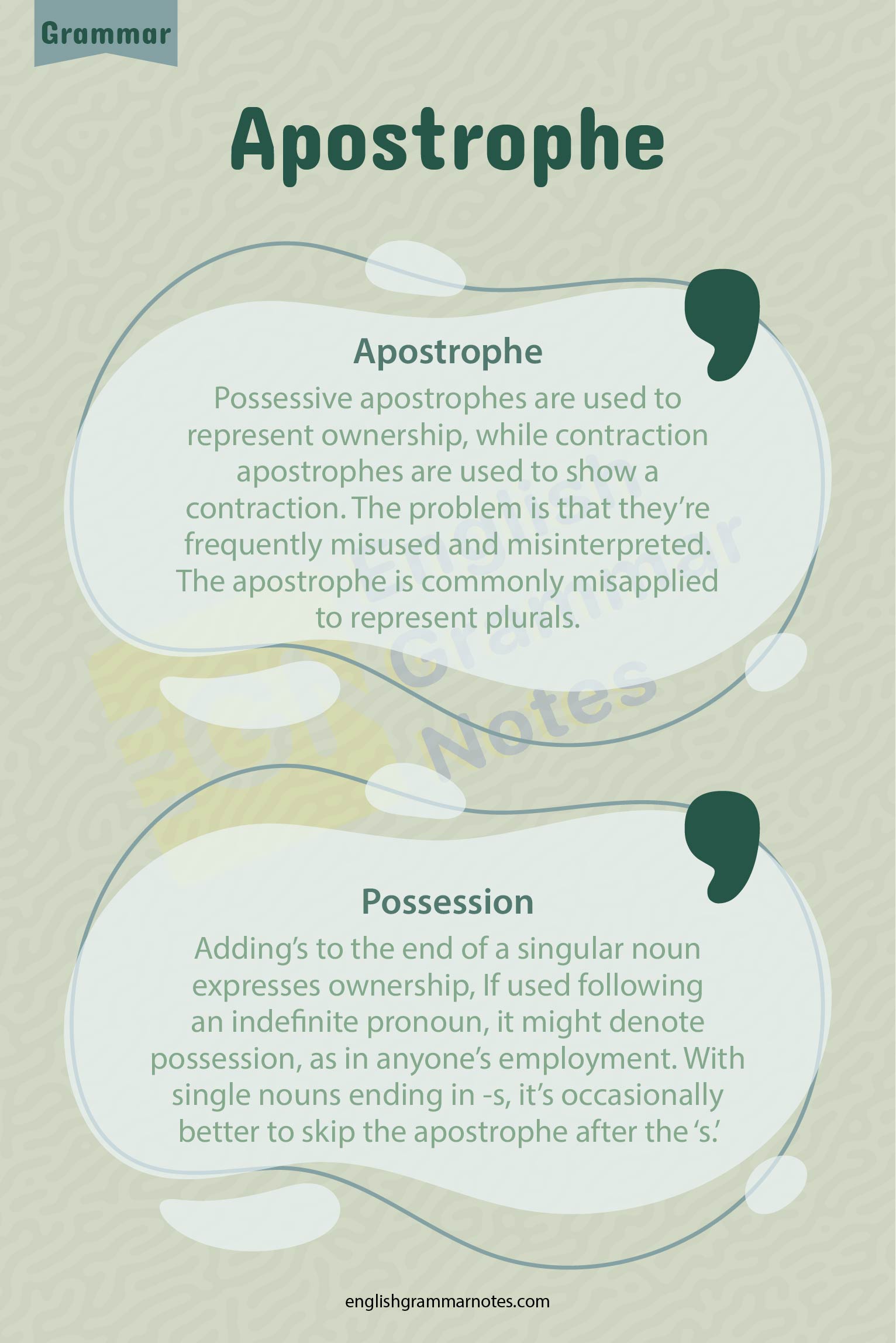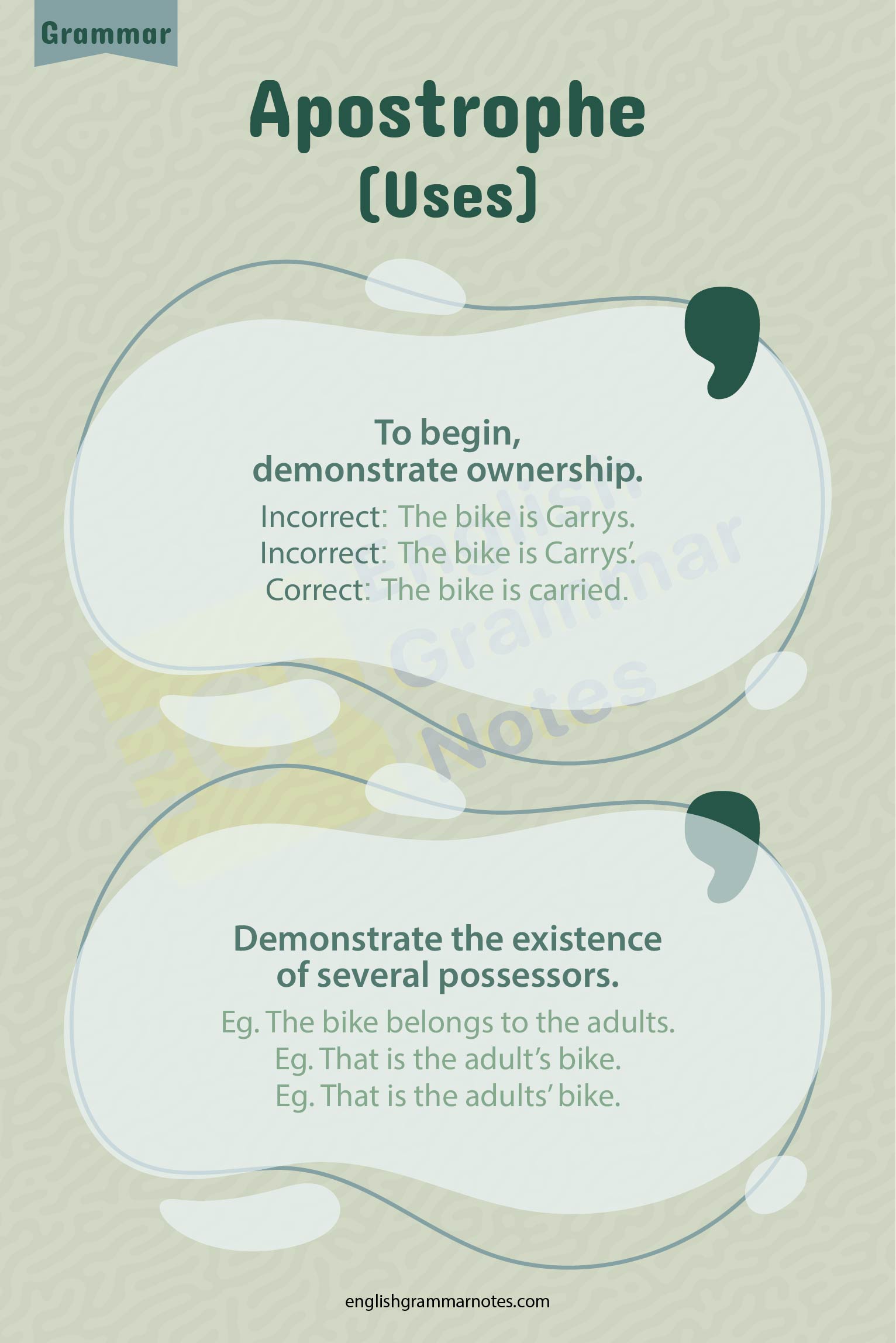Apostrophe: Possessive apostrophes are used to represent ownership, while contraction apostrophes are used to show a contraction. The problem is that they’re frequently misused and misinterpreted. The apostrophe is commonly misapplied to represent plurals. So, how do you know if you’re using this comma correctly?
Possession
Adding’s to the end of a singular noun expresses ownership, as in the sentences above. If used following an indefinite pronoun, it might denote possession, as in anyone’s employment.
With single nouns ending in -s, it’s occasionally better to skip the apostrophe after the ‘s.’ For example, the cactus’ flower. To make it understandable, some editors or authors may want to replace the word “cactus” with “flower” instead.
If you’re using an apostrophe after a plural noun ending in -s, you’ll see this:
However, would it be used for plural nouns that do not end in -s? “The children’s toys,” not “the children’s toys,” would be an example of an acceptable alternative spelling. The apostrophe is no longer required in the names of well-known shops and businesses that were once shown to be possessives.
The Apostrophe Protection Society has instructed Boots, Barclays, Selfridges, and Currys to put their apostrophes back on their products. When modifying, it’s a good idea to keep an eye on the names listed below to see whether the usage policy has changed.

Plurals
Using an apostrophe to indicate plurals is a common blunder. In markets, tiny shops, and pubs, this is something you’ll frequently encounter. Thus, it has been dubbed “the apostrophe of the greengrocer”! Apostrophizing plurals is improper; therefore, stay away from mistakes like these.
Contraction
Apostrophes can serve as a graphical representation of missing letters. Can’t, don’t, and wouldn’t are typical instances. There are contractions of lengthier words, but you aren’t obliged to use an apostrophe to indicate this since the truncated words are now considered separate terms. It would be bizarre to see familiar words like “bus” and “plane” spelt with apostrophes to show shorter variants of the original text.
Names Of Geographical Locations
The apostrophe or s must be used when writing location names because there is no shortcut to understanding this. It’s necessary to become familiar with each situation on its own. Consider the following examples: Kevin’s Court (no apostrophe), yet, Offa’s Dyke (apostrophe).
Editing by a professional
The professional editor may require editing quotes or other parts of the text in a different language. Therefore, you must be aware of how the apostrophe should be treated in certain circumstances. For example, suppose a sentence begins with an apostrophe in Afrikaans. In that case, the following word will be capitalized because the indefinite article appears as ‘n ‘and is never capitalized, even at the beginning of a sentence.
Are You Unsure About When An Apostrophe Should Be Used?
This punctuation mark causes a lot of confusion for a lot of people. Understanding when and why apostrophes are used is the best method to utilize them correctly.
- Possession is indicated with apostrophes.
- Omissions are shown with apostrophes.
The use of either its or it is often a source of confusion for people (with an apostrophe). Is this information available in the section under it’s or its?
Possession Is Indicated With Apostrophes
You use the apostrophe to indicate that an item or person belongs to or is related to something or someone else. For example, you could write Ben’s party and yesterday’s weather instead of saying Ben’s party or yesterday’s weather.
The following are the most important rules to remember when employing apostrophes to convey ownership:
Personal Pronouns And Singular Nouns
Singular nouns and names that are incredibly personal can be used in this way: add an apostrophe and the letter s at the end of the sentence:
- Ben’s birthday party is where we first met.
- The dog’s tail was wagging furiously in response.
- It rained all day yesterday.
Names Ending in -s for People
For personal names ending in -s, add an apostrophe and as when saying the word aloud naturally results in extras:
- In 1642, he enlisted in Charles’ army.
- Dickens’ books offer fascinating glimpses into life in Victorian England.
- The incident resulted in the injury of Thomas’s sibling.
This guideline is not always followed, especially when writing the names of places or organizations, such as:
- The Hospital for Sick Children at St. Thomas
If you’re unsure how to spell a name, look it up on a reputable website like the one for the organization.
Add an apostrophe to personal names ending in -s that aren’t spoken with a second:
- The court threw out bridges’ appeal.
- In 1991, Connors gave his best performance ever.
s-finalized plural nouns
When the plural noun already has a -s suffix: after the s, add an apostrophe:
- A girls’ school was established in the former home.
- As part of my job, I had to clean the horses’ stalls.
Nouns with plural forms ending in -s
Nouns ending in –s are singular. add an apostrophe and the letter s at the end of the sentence:
- The father of the children dropped by to say hello.
- At his men’s clothes boutique, he has a staff of 14.
Only possessive pronouns and possessive determiners require no apostrophe to express belonging. These are the terms his, hers, ours, yours, and theirs (meaning ‘belonging to him, her, us, you, or them’). When you hear someone say “his” or “her,” it usually means “belonging to or associated with” (meaning “belonging or affiliated with”). See also: is it s/he/they?
Omission-indicating apostrophes
When letters or numbers have been omitted, an apostrophe might be used to indicate that. These apostrophes denote the absence of a letter:
- I’m – a shortened version of I am.
- shorthand for “he’ll”
- the shortened form of she’d is she had, or she’d
- To pick and mix, we say “pick ‘n’ mix.”
- Tea is hot – abbreviation for it is extremely hot
- shorthand for “didn’t.”
In addition, it demonstrates that digits have been deleted, especially in dates, such as the fall of the Berlin Wall in 1989 (short for ’89).
To that end, here are the six proper ways to use the apostrophe, as well as one wrong approach.
Use of the Apostrophe
Due to a general lack of understanding of the regulations, this was the most popular choice. The sounds that words create when spoken by two people are the same. Despite its obvious usefulness on paper, I’ve found that most people aren’t aware of where or how to utilize it. Apostrophes can be used in six distinct ways if they are correctly employed. I’ve also included one in which the apostrophe is frequently misused.
To begin, demonstrate ownership.
Incorrect: The bike is Carrys.
Incorrect: The bike is Carrys’.
Correct: The bike is carried.
The second method is to demonstrate the existence of several possessors.
Sentence one: The bike belongs to the adults.
Sentence two: That is the adult’s bike.
Sentence three: That is the adults’ bike.

The sentences in each of the three examples are correct. There is no apostrophe in the first sentence. According to the second report, the bike belonged to an adult. According to the third, the bike is owned by more than one adult.
Showing plurality is a third option. When the possessor’s last name ends in s,’ this cardinal rule applies. Instead of placing the apostrophe inside the word, we place it outside to signify ownership when this occurs.
Incorrect: That is Samar’s bike.
Correct: That is Samars’ bike.
Apostrophes are used in five different ways, and the fifth approach is arguably the most difficult to grasp. “It is” is the subject of the argument. When should you use “it’s” instead of “its,” and when is “it’s” appropriate?
“It’s” is an abbreviation when used as a contraction. It’s a compound word that includes both “it” and “is.” You can get this one right by simply repeating the sentence out to yourself.
- Wrong: It’s a terrible concept.
- Correct: It’s a horrible concept.
Incorrect use of apostrophes in a sixth way has to do with the author’s voice. When writing, the voice we adopt will be determined by the subject matter and the audience. Whether or not to use apostrophes will be determined by the target audience or the genre of content. I’m going for a casual, conversational tone with this piece.
The final example demonstrates a common apostrophe usage mistake. This time, the subject is diversity.
Incorrect: This Company has been around since the 1970s.
Correct: This Company has been around since the 1970s.
To summarise, we never use an apostrophe to indicate the presence of more than one item in a group.
There’s a lot of grammar there to keep track of. Using good grammar is critical if you want to be taken seriously as a writer and author. Most of the time, I drew a business plan with investors in mind. I’m the one making the request. Typical grammatical faults will put a proposal on the chopping block.
As a result, the writing is sloppy and disorganized. I don’t want to be distracted by poor grammar when reading the material. Many people want to be authors, and I’m sure you’re one of those people. Keep in mind these guidelines. If you follow their advice, you may find a far more considerable following than you anticipated.